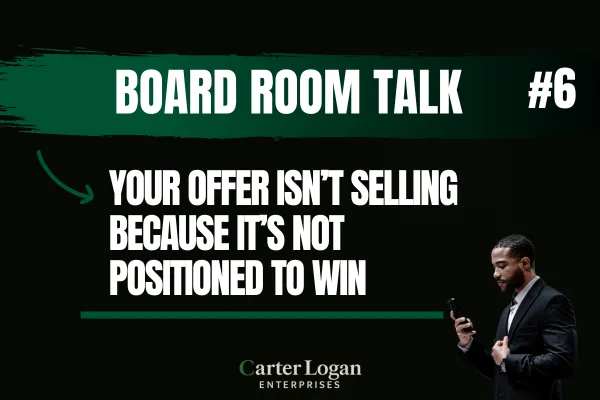
Your Offer Isn’t Selling Because It’s Not Positioned to Win
The problem isn’t your product or service—it’s how you’ve framed it.
Introduction: Great Offers Still Fail When They're Framed Wrong
You’re talented. You’ve got a real skill. You’ve created something valuable.
But people aren’t buying.
Or they’re ghosting after the sales call.
Or you get interest but no conversions.
That doesn’t mean your offer sucks. It means your positioning does.
If people don’t see the value, they won’t pay the price—even if it’s worth it.
This post breaks down why good offers underperform, how positioning determines perceived value, and what to fix to finally get paid what you’re worth.
What Positioning Really Means
Positioning is not branding.
It’s not your logo, your colors, or your font.
It’s not the tech stack or your social media strategy.
Positioning is how your offer is understood in the mind of your ideal client.
It answers one question:
“Why should I buy this from you, and why now?”
If your offer doesn’t answer that instantly and clearly, you lose—even if the offer is excellent.
Signs Your Offer Is Poorly Positioned
People say “let me think about it” after hearing your pitch
You get engagement but few actual buyers
Your competitors with less skill are charging more
You feel pressure to lower your price just to get the sale
You’re stuck trying to convince instead of convert
Why Positioning Makes or Breaks Your Sales
Here’s what strong positioning does:
Makes your offer feel urgent
Separates you from competitors
Justifies premium pricing
Makes the buying decision easier
Increases perceived value before they even hear your price
Think of positioning as the frame.
A Picasso in a trash bag looks like garbage.
A $50 print in a luxury frame looks like a masterpiece.
You don’t need a new offer. You need a new frame.
5 Keys to Winning Offer Positioning
1. Start With the Problem, Not the Product
People don’t buy features. They buy solutions to problems.
Ask:
What pain is my offer solving?
How urgent is that pain?
What are they already doing (or failing to do) to fix it?
Until your offer is the obvious solution to a painful problem, it’s a hard sell.
2. Narrow Your Target (Go Deeper, Not Wider)
If your offer is “for everyone,” it’s for no one.
Focus on a specific:
Pain point
Stage of business/life
Market vertical
Identity or belief system
Narrow positioning builds fast trust and makes your solution feel tailored.
3. Name the Enemy Clearly
Every powerful offer positions against something:
A broken system
An outdated method
A misunderstood idea
A common mistake
People don’t just need a “new way”—they need a reason to abandon the old way.
4. Price for Value, Not Labor
If you’re pricing based on how long it takes you, you’ve already lost.
Instead:
Price based on the result it creates
Price based on what it’s worth to the client’s life or business
Make the cost of inaction greater than the cost of purchase
5. Make the Outcome Tangible and Easy to Picture
People don’t buy coaching. They buy transformation.
Your offer should help them picture:
What changes in their life
What stress goes away
What they’ll gain (status, peace, time, income)
When they can see the end result clearly, buying becomes easy.
Final Word: Frame It Like It Deserves to Win
Your offer isn’t dead.
It’s just poorly packaged.
You don’t need to change the product. You need to upgrade the perception.
Think like a strategist, not a service provider.
Clarify the pain.
Sharpen the promise.
Nail the positioning.
Then watch what happens.
